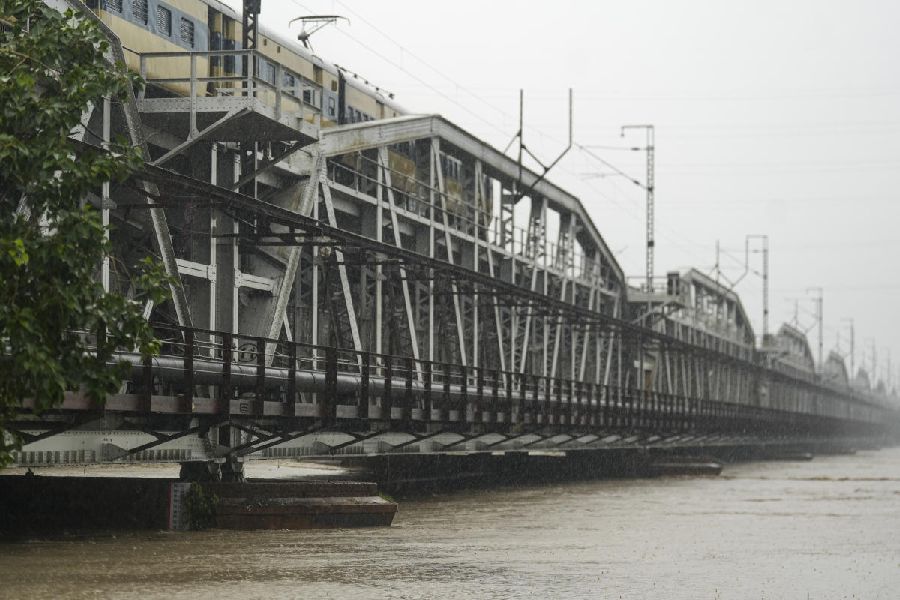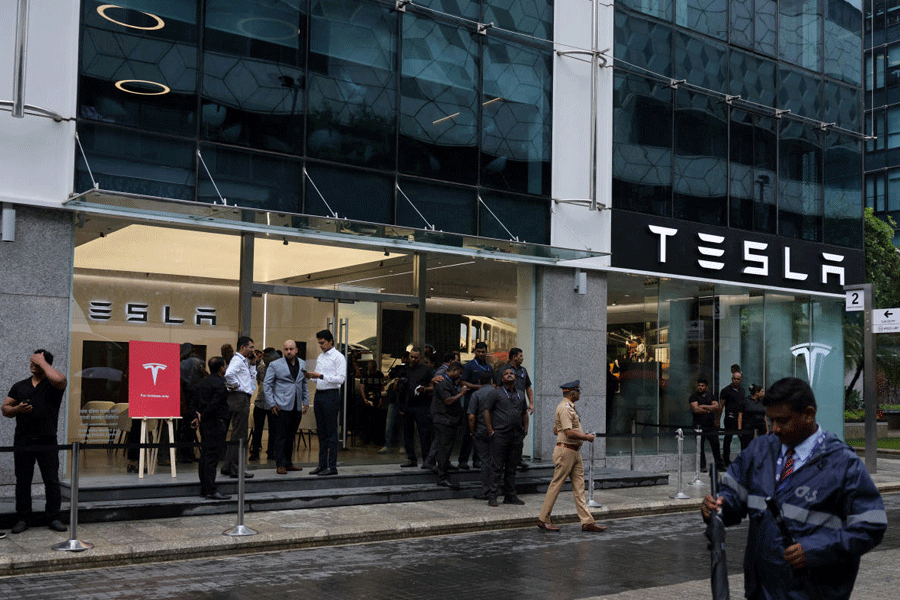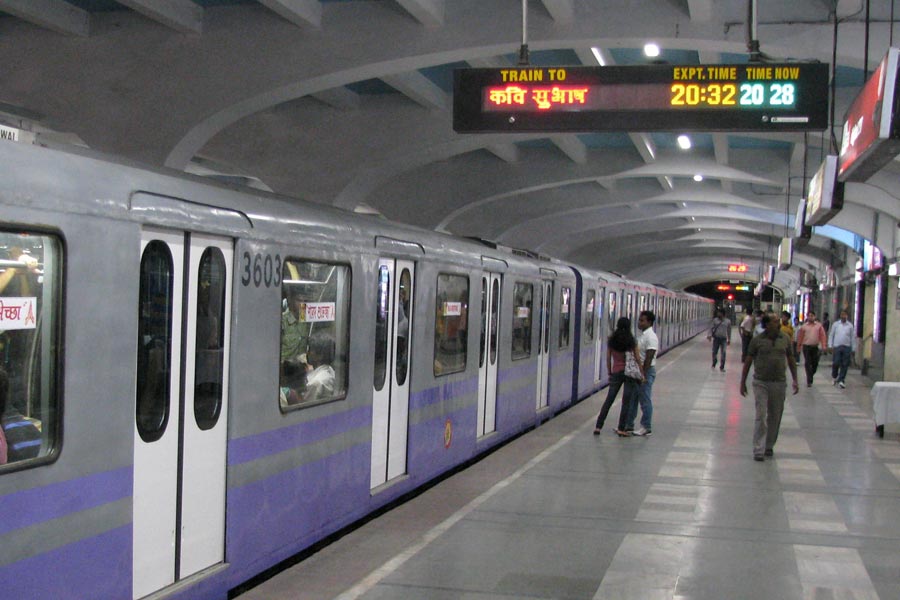 |
Once you have stepped inside the building with the smart, snow-white façade and are climbing the wooden staircase, there is no way you could tell this is actually part of a decrepit old house that faces Middleton Row. As you walk up the two flights of stairs, you confront yourself in the wall-to-wall mirrors on each landing. This is 2 Camac Street, with a giant vinyl signboard glowing across its face that conceals the walls that have shed their plaster. A smaller vinyl signboard on the portal, too, announces the name of the same software training institute whose office occupies the refurbished mews of No. 2.
No. 2 is a large house surrounded by a mews. As a face-saving exercise, as it were, only the section of the mews adjacent to Loreto House are kept in good repair. Is the rent higher here? The software training institute looks bright and modern in red, white and black. A wall of dimpled glass at least six inches thick separates the office.
Another entrance to the building also on Middleton Row looks even more spiffy — everything in unblemished white, staircase included. But the third entrance to the mews facing Camac Street is filthy. The staircase is of marble but the roof looks like it may fall anytime on anybody’s head. The banyan tree on the pavement with a tangle of aerial roots hanging from it increases the sense of decrepitude.
In fact, what looks like the single-storeyed outhouse at one end of the courtyard, is plastered with the Corporation’s notices screaming: “Beware. Building is unsafe.” The courtyard is a dump, where mountains of debris and giant rusting joists have piled up around the mango trees.
The main building beyond the mews is handsome but shabby. I was lucky to run into Akshyay Chand Jain, 78, who has occupied the top floor for the past 30 years or even more. His son Lalit is an interior decorator, and he caresses with pride the carved wood banisters, which he claims are of Swedish origin.
Although the sprawling synthetic velvet sofas and modular furniture do not really match the loftiness of this apartment, thanks to the Jains, they have done nothing to desecrate the spirit of the building, where, I soon find out from the old man himself, that Arathoon Stephen, one of the founding fathers of the Grand Hotel, lived and died. Akshaybabu’s grandchildren are of peaches-and-cream fairness with eyes of coordinated lightness, naturally. The granddaughter is a tall and beautiful girl in trousers. The studs in her ears flash blue sparks.
Camac Street may have turned into a marketplace but it is so easy to stumble upon royalty here, even in our rough-and-ready times where nothing is sacred. There is no mistaking that Dumraon House built in 1922 is a reference to a fiefdom in Bihar, whose titular head still enjoys the appellation of maharaja.
No 3E looks haunted from without. The house belongs to the Singh Deos of Seraikella of Chhau dance fame. But the royal flat is locked and the other residents of the building wary of strangers. Two youngsters point out a tiny gate behind the house where a solitary bulb is burning in the dark. This is presumably the outhouse. A woman sitting outside switches on a light inside a tiny room. A man in a dhoti is lying on a cot. A raja in reduced circumstances?
The man takes my card and opens another gate in the semi-darkness. He returns moments later accompanied by another man, whose rosy skin and chiselled nose speak volumes about his pedigree. He introduces himself as Kamakhya Singh Deo, 50.
He leads me to his quarters that are simple and neat. But the postern he opens to let me in reveals a large manicured lawn and flowerbeds with a simul tree towering above them. As in Dumraon House, the lawn is hemmed in on two sides by highrise apartments. Singh Deo, a man of few words, says the tennis court was sold off years ago and the Mansarovar building has come up on that plot.
Old houses seem to be caught in a time warp. They preserve an era gone by. I meet three generations of the Gooptu family in their residence at 7B Middleton Street. The room of enormous proportions has a fireplace — a common feature in these bungalows. The furniture is heavy and dark. They moved into this house from Jorasanko about 80 years ago. They went to English-medium schools but are still Bengalis to the core.
They speak of a time when the quiet street was gaslit, itinerant children would sing carols during Christmas and every noisy Hindu festival would be celebrated with fervour at their home, much to the annoyance of their European neighbours. Even 50-ish Deep remembers their herd of 14 deer that would occasionally amble as far as Chowringhee – the road was so secluded.
A young girl in shorts with a baby in her arms appears on the verandah. A lady of the house passes by busily. She wears the sari workaday matronly-style. The groundfloor of the house is an enormous Bata showroom now.
I gather from the Gooptu elders that the two-storeyed building, where the state secretariat has come up now, had some Russian connection and they remember the music that wafted on the breeze on some nights. Another friend remembers 22 Camac Street of yore, where the burrasahibs of the Inchcape Group used to live once. Pantaloons and Westside have been constructed there. The plot on which the biggest man-made firetrap on Camac Street, Vardaan Market, was built once belonged to the Ranas of Nepal.
The heritage committee has allowed Sir Biren Mookerjee’s residence to be separated from the lawn and so it has been sold off to the highest bidder. It is a parking lot now, and from the look of things, will soon turn into a garbage dump.
It is difficult to dissociate Camac Street from its past. Now the street could earn the distinction of having spawned a style of architecture whose vulgarity and tawdriness is beyond compare.
The department stores — glass boxes with acanthus-topped pilasters and grandiose gates — have the unreality of film sets. The state secretariat is a colossal visage from which the features have been deleted — like the victim of an acid attack. No 4/1 Camac Street is by far the best preserved bungalow, and even the shops with their bull-nosed canopies that have opened on the groundfloor are not at variance with its graciousness.
The property of the ICICI Bank next to the department stores waits to be demolished.











